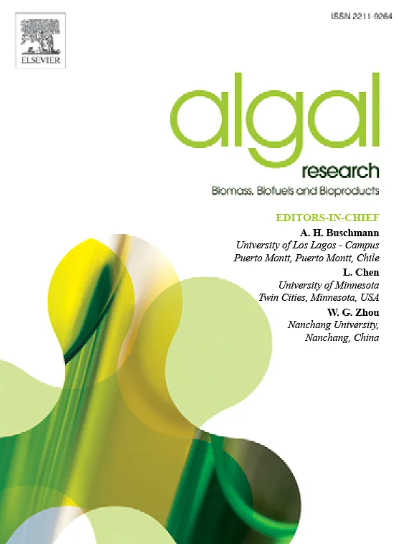Microalgal mixotrophic cultivation enhances lignocellulosic pretreatment wastewater utilization: Inhibitors detoxification process and C5/C6 sugar high-value conversion
IF 4.6
2区 生物学
Q1 BIOTECHNOLOGY & APPLIED MICROBIOLOGY
Algal Research-Biomass Biofuels and Bioproducts
Pub Date : 2025-03-17
DOI:10.1016/j.algal.2025.104007
引用次数: 0
Abstract
Algae, with their strong carbon fixation capacity and ability to accumulate high-value products, hold significant potential for utilizing lignocellulosic pretreatment wastewater (LPW). However, effective bio-detoxification of inhibitors and the efficient utilization of C5/C6 sugars in LPW are critical for the successful application of algae in resource utilization. This study investigates the effects of typical LPW inhibitors—furfural and vanillin—on the physiological and biochemical properties of Chlorella sorokiniana under mixotrophic conditions. Additionally, the biodetoxification of these inhibitors and the conversion of C5/C6 sugars into high-value products were examined. The results demonstrated that C. sorokiniana could tolerate up to 0.5 g/L furfural and 0.25 g/L vanillin during mixotrophic growth. However, exposure to furfural, vanillin, and their combination significantly inhibited algal antioxidant enzyme activities and ribulose-1,5-bisphosphate carboxylase/oxygenase (Rubisco) function, leading to damage to the photosynthetic apparatus and a reduction in the conversion of high-value products. Despite these challenges, the algae were able to convert these inhibitors into less toxic compounds, such as alcohols and acids, through both photosynthesis and respiration, achieving a 100 % conversion rate within the first three days of exposure. Moreover, C. sorokiniana effectively utilized C6 sugars for biomass accumulation, which comprised 41.12 %–55.96 % protein, 12.32 %–19.89 % lipids, and 20.06 %–44.65 % carbohydrates. Additionally, the algae successfully converted C5 sugars into xylitol, a high-value product. These findings provide valuable insights into the potential of algal systems for resource utilization from lignocellulosic biomass, as well as the cost-effective production of valuable algal biomass and by-products.

求助全文
约1分钟内获得全文
求助全文
来源期刊

Algal Research-Biomass Biofuels and Bioproducts
BIOTECHNOLOGY & APPLIED MICROBIOLOGY-
CiteScore
9.40
自引率
7.80%
发文量
332
期刊介绍:
Algal Research is an international phycology journal covering all areas of emerging technologies in algae biology, biomass production, cultivation, harvesting, extraction, bioproducts, biorefinery, engineering, and econometrics. Algae is defined to include cyanobacteria, microalgae, and protists and symbionts of interest in biotechnology. The journal publishes original research and reviews for the following scope: algal biology, including but not exclusive to: phylogeny, biodiversity, molecular traits, metabolic regulation, and genetic engineering, algal cultivation, e.g. phototrophic systems, heterotrophic systems, and mixotrophic systems, algal harvesting and extraction systems, biotechnology to convert algal biomass and components into biofuels and bioproducts, e.g., nutraceuticals, pharmaceuticals, animal feed, plastics, etc. algal products and their economic assessment
 求助内容:
求助内容: 应助结果提醒方式:
应助结果提醒方式:


